
by Heidi Copeland | Mar 23, 2021
 Do you quality for the Earned Income Tax Credit (EITC), or Earned Income Credit (EIC)?
Do you quality for the Earned Income Tax Credit (EITC), or Earned Income Credit (EIC)?
The Earned Income Tax Credit (EITC), or Earned Income Credit (EIC), is a refundable tax credit targeted to working people with low to moderate income.
EIC is a refundable credit. You can take advantage of the credit even if you do not owe any taxes. (https://www.irs.gov/pub/irs-prior/p596–2020.pdf)
Plus, there is a new feature… the LOOKBACK rule for Earned Income Credit (EIC).
As part of the Consolidated Appropriations Act of 2021, passed in December of 2020, you can use your 2019 earned income to determine your EIC and the Additional Child Tax Credit if your 2020 earned income is lower than your 2019 earned income. This is an especially important rule. You can use whichever income gets you the larger credit.
To qualify for the EIC:
- You must have at least $1 of earned income: wages, salary, tips, net self-employment earnings (income less expenses), or disability benefits up to a certain threshold
- You file a federal income tax return for the tax year even if you do not owe any tax or are not required to file a tax return
- Taxpayer (and spouse) and any qualifying child must each have a valid Social Security number issued before the due date of your return
- Taxpayer must be a U.S. citizen or resident alien for the entire year
- Filing status can be married filing jointly, head of household, qualifying widow(er), or single. (You can’t claim the EITC if your filing status is married filing separately)
- Your tax year investment income must be $3,650 or less for the year
- Cannot file form 2555 relating to foreign earned income
- Rules for qualifying children:
- Child(ren) must be under age 19—age 18 or younger—at the end of the tax year and younger than you or your spouse (if you file jointly) OR under age 24 and a full-time student and younger than you or your spouse (if you file jointly) OR any age if permanently and totally disabled
- The child must either be your son, daughter, stepchild, foster child, brother, sister, stepbrother, stepsister, or a descendant of any of these individuals, which includes your grandchild, niece, or nephew
- The child must have lived with you for more than half of the tax year (some exceptions apply)
- Only one person can claim the same child for the same tax year
The EIC may be disallowed if the taxpayer incorrectly files for the credit but does not meet these requirements.

by Heidi Copeland | Mar 23, 2021
 Friday, February 12, 2021 opens the 2021 income tax filing season. Getting your income tax information together will help you file a complete, correct, and timely income tax return.
Friday, February 12, 2021 opens the 2021 income tax filing season. Getting your income tax information together will help you file a complete, correct, and timely income tax return.
Things to know:
- 2020 return is filed in 2021
- As of now, April 15, 2021 is still the filing deadline
- File on time or file for an extension to avoid paying a penalty for failing to file on time.
- If you are owed a refund, you have up to 3 years to file and receive the money.
Coronavirus and Taxes
The Coronavirus Aid, Relief, and Economic Security Act (CARES Act) authorized the IRS to issue Economic Impact Payments (EIPs)
- EIP1: $1,200 to most U.S. citizens and residents and up to $2,400 for married couples who file a joint return plus $500 per qualifying child.
- EIP2: $600 for individuals or $1,200 for married couples and up to $600 for each qualifying child.
- Generally, if you have an adjusted gross income for 2019 up to $75,000 for individuals and up to $150,000 for married couples filing joint returns and surviving spouses, you will receive the full amount of the second payment. For filers with income above these amounts, the payment amount is reduced.
On the 2020 Form 1040 (individual income tax return), taxpayers are asked about these monies. Did you get them and how much? Be aware that these funds were disbursed in different ways: paper check, direct deposit, and debit cards. Many people also received a notice 1444 A or B explaining these monies; many did not. It is important to familiarize yourself about the Economic Impact Payments (EIPs) and know the exact amount you received. (If you didn’t receive the funds, ask yourself these questions: Have you filed an individual income tax return in previous years? Have you moved/changed bank accounts since filing last?)
Remember, putting incorrect information on the tax return might mean a lengthy delay or alter the size of refunds/payments!
Know, too, that after October 15, 2020, the only way to claim your EIP will be to file a federal income tax return. If you did not file a 2019 tax return in 2020, you may instead be able to claim a recovery rebate credit when you file your 2020 federal income tax return in 2021.
People can check the status of both their first and second payments by using the Get My Payment tool, available in English and Spanish only, on IRS.gov or calling the IRS hotline @ 800-919-9835.

by Samantha Kennedy | Mar 17, 2021
Food waste is a huge problem here in the United States. Here are a few incredible facts: Food is the most common solid source of waste in American landfills. Anywhere from 25-40% of food grown, processed, and transported in the US will never be eaten. Food waste harms the environment and results in a lot of wasted money.
Looking for ways to reduce food waste? Just follow these six tips.
Plan meals carefully. Only purchase what will be eaten in a reasonable amount of time, especially perishable items. Buying large quantities of fresh produce, dairy, and other perishables may seem like a time-saving practice. However, throwing spoiled food away not only wastes money, but also time, since the spoiled items need to be replaced during another trip to the market.
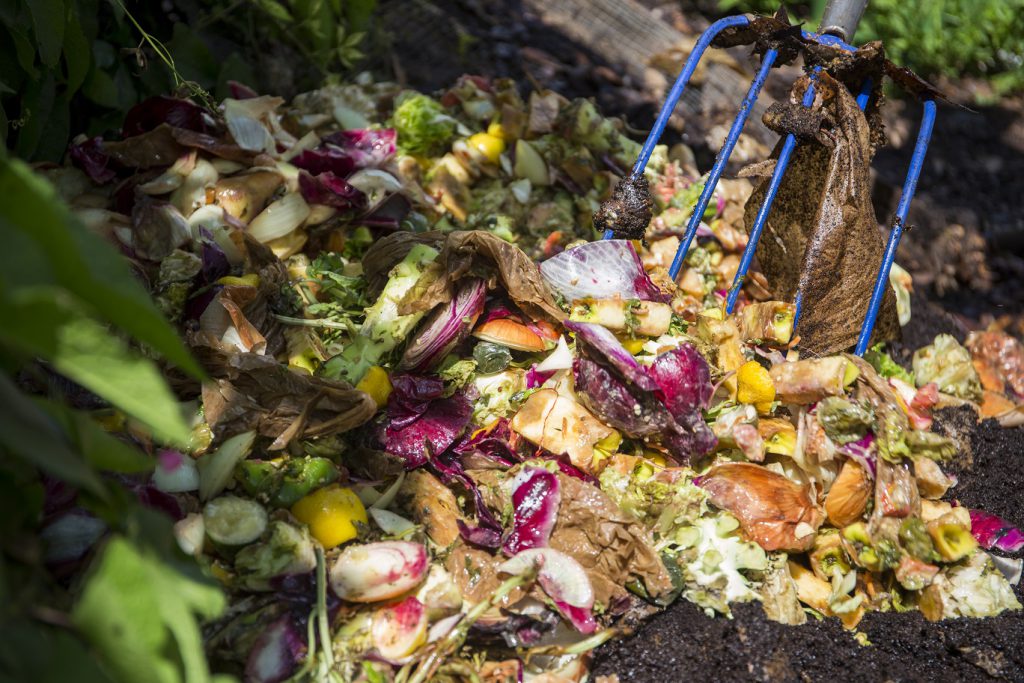
Instead of throwing old fruits and vegetables away, turn them into nutrient-rich compost to help your garden thrive. (Photo source: Camila Guillen, UF/IFAS)
Freeze or re-use food whenever possible. Not all food freezes well. However, fresh fruits and vegetables freeze quickly and easily when handled properly and can last in the freezer for months. Vegetable scraps are also great for making compost, which enriches the soil and can help support the growth of backyard gardens.
Look at the sell by/use by/best by dates on food products. Try to purchase items with the longest shelf-life (the latest date) available. If a product is close to its sell by date, be sure to use it or freeze it quickly. Keep in mind, however, that just because a product is past its use by date does not mean it is unsafe to eat. Take it on a case-by-case basis. If there is no mold, pests, off odors, off colors, or off textures, the product is safe to consume. This is especially true for dry, non-perishable items.
Store food properly. Storing foods at the wrong temperatures can speed up the spoilage process. Keep the refrigerator between 37 and 39 degrees Fahrenheit. Dry goods storage should ideally be around 50 degrees F, but since this is not realistic for most of us, just make sure dry goods are stored in a cool, dry place outside of direct sunlight.
Stay organized. Arrange items so that the oldest stuff is in front. This helps ensure it is used first. Always label frozen foods with the item name and date it was first frozen and use within 12 months whenever possible. Foods frozen for longer than a year start to diminish in flavor and texture. Old food also tends to attract pests, so making sure things are used efficiently can help eliminate the risk of insects and rodents.
Donate non-perishables to those in need. Food banks and other community organizations are always looking for food donations to help the hungry. Non-perishable foods that have not surpassed their use by/sell by dates are always welcome donations. Instead of trashing it, share it with someone less fortunate.
In most cases, food affected by flood damage or other disasters should be discarded for safety reasons. Better to be safe than sorry. However, everyday food waste is completely avoidable if a few simple rules are followed. The amount of food thrown away each year in the US is disheartening. When shopping, being a little more mindful of quantities and dates can help reduce overall food waste, saving both money and the environment.
Additional Resources:
National Center for Home Food Preservation (University of Georgia Extension)
Food Waste Resources (Kansas State University Extension)
UF/IFAS is an Equal Opportunity Institution.

by Angela Hinkle | Mar 11, 2021

FCS Agent: Angela Hinkle Photo Source: UF/IFAS
Angela Hinkle is a Family and Consumer Sciences Agent in Escambia County, specializing in increasing the healthy food and nutrition behaviors of limited-resource families. She graduated from the University of Maryland in Broadcast Communications. After giving birth to a beautiful daughter, she worked for NC State on a grant helping moms breastfeed their new babies. She was offered additional duties from another grant – EFNEP (Expanded Food and Nutrition Education Program). After the breastfeeding grant program ended, Angela re-located to Escambia County, Florida and was able to continue teaching efforts as a program assistant for the EFNEP program there.
As a single mom, Angela really appreciated the help of family, friends, and co-workers in advancing to the position of UF Extension Agent in 2008 and getting her master’s degree in Health Education (with a psycho-social emphasis) from the University of West Florida in 2010.
Along with her staff, Angela works with limited-resource youth and families, educating them in choosing, preparing, and eating healthy when budgets are severely restricted. She says it is definitely a challenge to help people make positive behavior changes and to assist communities in making the healthy choice the easy choice. But she says the successes that participants and community partners share about caring for their families in healthier ways always make it worth it.
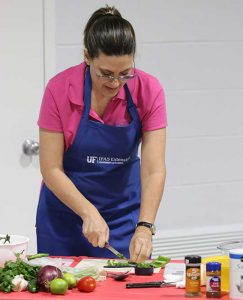
Angela Hinkle Prepares Salsa Photo Source: William Reynolds
Other health and wellness Family and Consumer Sciences programming Angela has led includes: “Keeping the Pressure Down,” “Wellness Wednesdays,” “Let’s Walk Florida,” “Cook Smart Eat Smart,” “Feed Them Well,” “Smart Shopping for Families,” and the Growing Series including “Growing a Healthy Pizza,” “Growing Nachos,” “Growing an Ice Cream Sundae,” and “Growing Brunch.”
Angela was born in Trinidad in the West Indies. Her family moved to a trailer on a dirt road in Pensacola, FL when she was about five years old. She then moved around to Maryland, Oklahoma, Indiana, and North Carolina before finally circling back to Pensacola. In each place she has lived, food has always been a big passion. She loves to read about food, talk about it, make it, share it, explore the culture and history behind it, and eat it in a variety of settings. This passion makes her a great fit for the EFNEP program.
Her soul animal is a turtle, (usually moving very slowly, enjoying time in her own shell, but moving surprisingly quickly when prompted). In addition to food, Angela likes being with her dog (who is getting on in years but likes to take her for a walk every morning), a nice warm cup of tea, going to the movies, reading for pleasure, traveling and sight-seeing, and getting to spend time with her adult daughter.

by Terri Keith | Feb 21, 2021
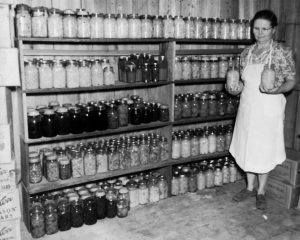
Homemade canned preserves 1942.
Photo Credits: UF/IFAS File Photo
In 1795, Napoleon needed a better way to preserve large quantities of food for his troops during the Napoleonic Wars, so his government offered a reward of 12,000 francs for the invention of a new food preservation method. In 1809, Nicolas Appert won that award with his canning technique that used glass containers that were sealed then heated to a set temperature. Peter Durand created the tin canister a year later. These inventions led to the canning materials and processes that are used today to preserve food for people all over the world.
Canned food provides a convenient and often less expensive way to include fruits and vegetables in the diet of many individuals and families. Canned foods are also considered a staple in many pantries because of their shelf life. Commercially canned products may keep the food packed inside at its best quality for 1 to 5 years depending on the type of food. Most home canned foods are able to be stored for up to a year, though there are some exceptions.

Photo Credit: UF/IFAS Photo by Tyler Jones
To make the most of canned foods, keep these tips in mind.
Best by or use by dates on commercial products do not indicate safety. They are estimated dates provided by the manufacturer on how long they believe their product would be at its best quality. The exception to this is for infant formula products that are required to have a “Use-By” date and should not be used after that date.
Avoid cans or jars that are not in good condition. Look for dents, swelling or bulging, leaking, rust, cracks in jars or loose lids. If the food has a foul odor or spurts liquid when it’s opened, do not use it. Any of these could indicate the food may have been contaminated or could contain Clostridium botulinum toxins.
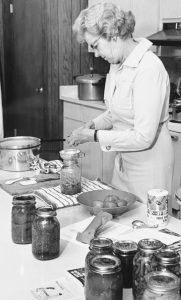
A woman canning in the kitchen.
Photo Credits: UF/IFAS File Photo
Store canned foods in a cool, dark and dry space. This will help them to last longer and keep the food inside at its best quality. Keep canned foods in an area that is between 50-70°F.
Use canned foods to fill nutrition gaps. Add a can of vegetables to your dinner menu—a side of green beans or carrots can help balance your plate. Try using a can of fruit as a basis for a dessert. Pineapple and cottage cheese, anyone? If you’re concerned about sodium or sugar in canned foods, look for products marked as low sodium or lite for less sugar. Compare ingredient and nutrition labels of different brands or varieties of a product to find what works best for you.
If you can foods at home, make sure you’re following recipes that have been tested for safety. Follow the guidelines in the USDA Complete Guide to Home Canning, 2015 Revision or find more information at the National Center for Home Food Preservation. You can also contact your local extension office; in Florida, you can find your local office here.
Resources:
U.S. Department of Agriculture, National Agricultural Library, How Did We Can?: https://www.nal.usda.gov/exhibits/ipd/canning/timeline-table
U.S. Department of Agriculture, AskUSDA, How long can you keep canned goods?: https://ask.usda.gov/s/article/How-long-can-you-keep-canned-goods
U.S. Department of Agriculture, Food Safety and Inspection Service, Food Product Dating: https://www.fsis.usda.gov/wps/portal/fsis/topics/food-safety-education/get-answers/food-safety-fact-sheets/food-labeling/food-product-dating/food-product-dating

by Kendra Hughson | Feb 21, 2021

Kendra during her professional development leave at Purdue University.
Kendra Hughson is a Regional Specialized Agent in Family and Consumer Sciences. She is based in Quincy, Florida and covers the sixteen counties in the panhandle. Kendra leads the northwest district county faculty in developing districtwide family and consumer sciences programs. Kendra is also currently serving as co-chair of the statewide family and consumer sciences program.
Kendra began her career with Michigan State University Extension in a suburban county in southwest Michigan after completing an internship program in the county office. With a bachelor’s degree in family studies, she intended to continue her education in marriage and family therapy while working as an extension agent. Kendra caught the “Extension bug” and ended up completing her master’s degree in Family and Consumer Sciences at Western Michigan University.
Kendra was hired with the University of Florida/IFAS Extension in 2007 leaving the snow, ice, and frigid winters behind. She has served as an agent, a county extension director, and returned to her passion for family and consumer sciences as a regional specialized agent. Kendra works primarily in health and wellness but enjoys the variety of family and consumer science programs. She studied evaluation during a professional development leave in 2018 and has since been passionate about telling the story of how family and consumer sciences programs improve the lives of the people with which we work.
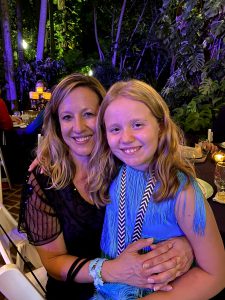
Kendra and her daughter in St. Petersburg, FL.
Kendra lives in Tallahassee with her daughter and dog. Kendra enjoys travelling, including playing tourist in the sunshine state and visiting Lake Michigan in the summertime. When not working or managing family activities, Kendra enjoys reading, cooking (not baking), sewing, and being outdoors.

 Do you quality for the Earned Income Tax Credit (EITC), or Earned Income Credit (EIC)?
Do you quality for the Earned Income Tax Credit (EITC), or Earned Income Credit (EIC)?











